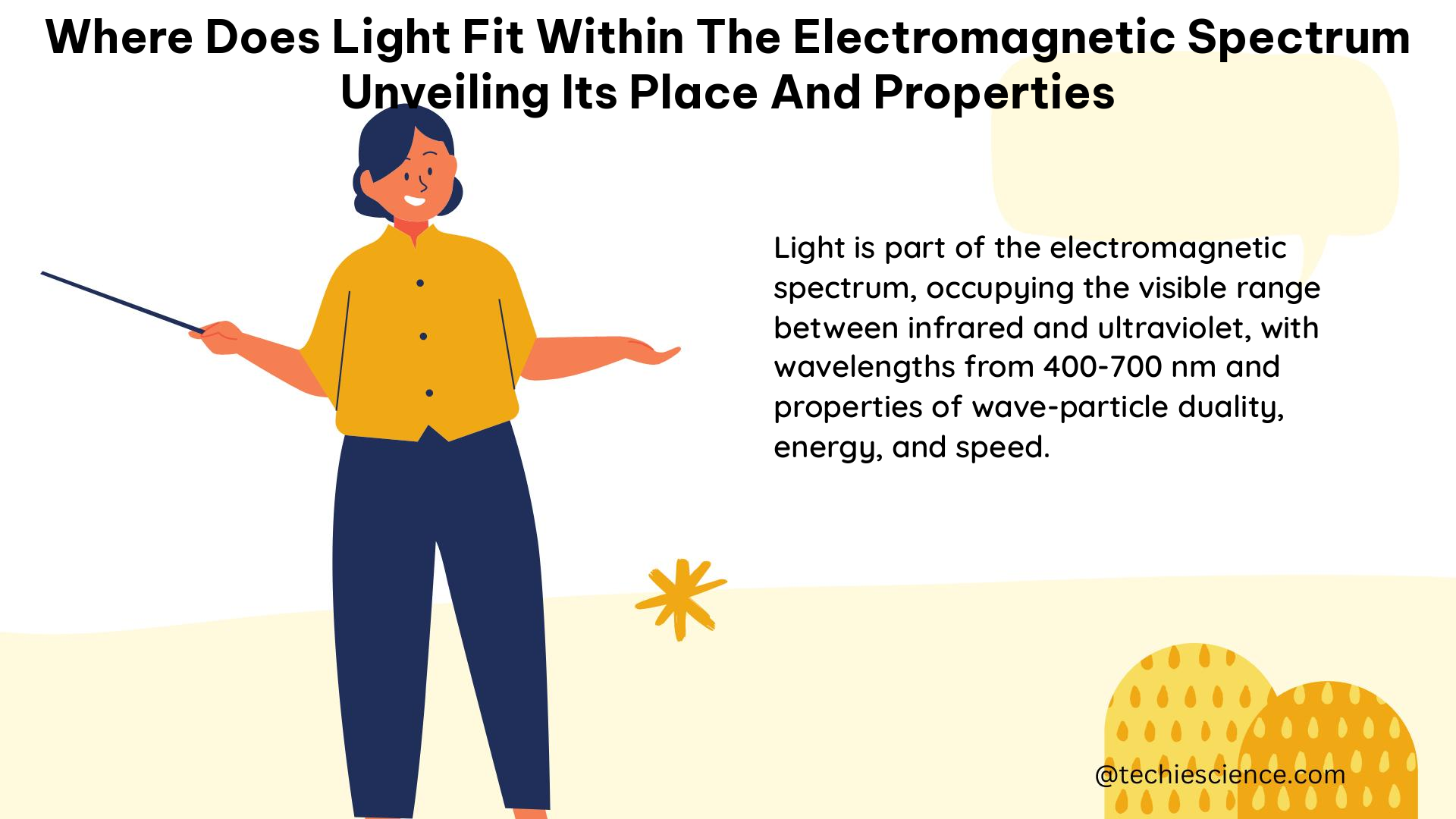Light is a form of electromagnetic radiation that occupies a specific region within the vast electromagnetic spectrum, with unique properties that have fascinated scientists and researchers for centuries. In this comprehensive guide, we will delve into the intricacies of where light fits within the electromagnetic spectrum, exploring its wavelength, frequency, and other key characteristics that define its place and role in the natural world.
The Electromagnetic Spectrum: An Overview
The electromagnetic spectrum is a vast and diverse range of electromagnetic radiation, encompassing a wide variety of wavelengths and frequencies. This spectrum can be broadly divided into several regions, including radio waves, microwaves, infrared, visible light, ultraviolet, X-rays, and gamma rays. Each of these regions has distinct properties and applications, with visible light occupying a relatively narrow band within the overall spectrum.
The Visible Light Spectrum

Visible light, the portion of the electromagnetic spectrum that is perceptible to the human eye, is typically defined as the wavelength range between approximately 400 and 700 nanometers (nm). This corresponds to a frequency range of roughly 430 to 790 terahertz (THz). Within this range, different wavelengths of light are perceived as different colors, with shorter wavelengths appearing as violet or blue, and longer wavelengths appearing as red or orange.
Theorem: The Relationship Between Wavelength, Frequency, and the Speed of Light
The relationship between the wavelength, frequency, and speed of light in the electromagnetic spectrum is governed by the following theorem:
c = λν
Where:
– c is the speed of light, approximately 3.00 × 10^8 m/s
– λ is the wavelength of the electromagnetic radiation
– ν is the frequency of the electromagnetic radiation
This theorem, known as the wave equation, is a fundamental principle in the study of light and the electromagnetic spectrum.
Physics Formula: Calculating Frequency from Wavelength
To calculate the frequency of light from its wavelength, we can use the following formula:
ν = c/λ
Where:
– ν is the frequency of the electromagnetic radiation
– c is the speed of light, approximately 3.00 × 10^8 m/s
– λ is the wavelength of the electromagnetic radiation
This formula allows us to determine the frequency of a given wavelength of light, or vice versa, using the known speed of light.
Physics Examples
Example 1: Calculate the frequency of light with a wavelength of 500 nm.
Solution: Using the formula ν = c/λ, where c = 3.00 × 10^8 m/s and λ = 500 nm = 5.00 × 10^-7 m, we get:
ν = (3.00 × 10^8 m/s) / (5.00 × 10^-7 m) = 6.00 × 10^14 Hz
Example 2: Calculate the wavelength of light with a frequency of 5.00 × 10^14 Hz.
Solution: Using the formula λ = c/ν, where c = 3.00 × 10^8 m/s and ν = 5.00 × 10^14 Hz, we get:
λ = (3.00 × 10^8 m/s) / (5.00 × 10^14 Hz) = 6.00 × 10^-7 m or 600 nm
Physics Numerical Problems
Problem 1: A spectrometer measures the spectral irradiance of a light source and finds that the peak irradiance is at a wavelength of 550 nm. What is the frequency of this light?
Solution: Using the formula ν = c/λ, where c = 3.00 × 10^8 m/s and λ = 550 nm = 5.50 × 10^-7 m, we get:
ν = (3.00 × 10^8 m/s) / (5.50 × 10^-7 m) = 5.45 × 10^14 Hz
Problem 2: An imaging colorimeter measures the chromaticity of a light source and finds that the x and y coordinates are (0.32, 0.38). What is the correlated color temperature (CCT) of this light?
Solution: To calculate the CCT, we need to use the chromaticity coordinates and the Planckian locus, which is a curve that represents the chromaticity of a blackbody radiator as a function of temperature. The CCT is the temperature of the blackbody radiator that has the same chromaticity as the light source. In this case, we can use the formula CCT = f^-1(x,y), where f is a function that maps the chromaticity coordinates to the CCT. The exact formula for f depends on the specific color space and color model used, and can be found in various standards and references.
Figures, Data Points, and Measurements
Figure 1: The electromagnetic spectrum, showing the wavelength and frequency ranges of various types of radiation, including visible light.
Data Point 1: The wavelength range of visible light is approximately 400-700 nm.
Data Point 2: The frequency range of visible light is approximately 430-790 THz.
Measurement 1: The spectral irradiance of a light source can be measured using a spectroradiometer.
Measurement 2: The chromaticity of a light source can be measured using an imaging colorimeter.
References
- “How to Measure a Spectrum” by William P. Blair, Blair.pha.jhu.edu
- “How could I measure the colour spectrum of a light bulb and investigate how closely it matches a black body radiation curve?” by user36790, Physics.stackexchange.com
- “Light Measurement Basics” by Konica Minolta Sensing Americas, KonicaMinolta.us
- “Light Measurement Devices: From Spectral Data to Imaging Colorimeters” by Radiant Vision Systems, RadiantVisionsystems.com

The lambdageeks.com Core SME Team is a group of experienced subject matter experts from diverse scientific and technical fields including Physics, Chemistry, Technology,Electronics & Electrical Engineering, Automotive, Mechanical Engineering. Our team collaborates to create high-quality, well-researched articles on a wide range of science and technology topics for the lambdageeks.com website.
All Our Senior SME are having more than 7 Years of experience in the respective fields . They are either Working Industry Professionals or assocaited With different Universities. Refer Our Authors Page to get to know About our Core SMEs.